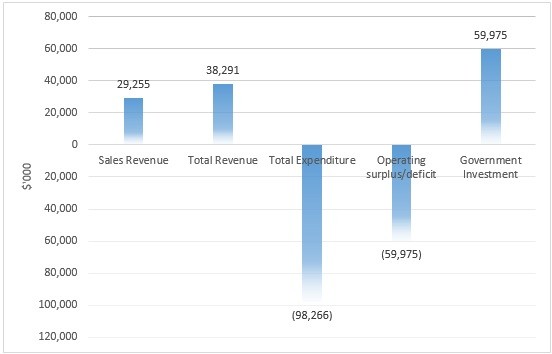
The Australian Grand Prix cost Victorian taxpayers $60 million in 2014, a whopping $9.3 million more than the previous year. That’s an 18% increase over 12 months and a lot of money for a long weekend (see exhibit).
One reason for the big increase was a drop of around $2 million in expected sales revenue attributed to the retirement from racing of Australian driver Mark Webber after the 2013 season.
** Closes midnight tonight! Follow this link to be in the running to win one of two copies of the Grattan Institute’s new book, City Limits **
But the main reason was costs went up by $7.5 million. The former government said last year this increase was mainly due to escalation clauses in the contract with Bernie Ecclestone it inherited from its predecessor i.e. the Bracks/Brumby Labor government.
At the time of last year’s race, the government claimed the economic benefits from the event are in the region of $32 million to $39 million. But no one seems to be spruiking them anymore.
That might be because it would draw attention to the gaping hole between the claimed (economic) benefits and the actual (financial) cost. Or it might be because the claimed benefits are so ludicrously over-stated that not even politicians can bring themselves to keep sprouting unadulterated crap.
A thorough analysis of the 2012 Grand Prix by consultants Economists at Large concluded the economic benefits from factors like tourism, international media exposure and consumer surplus are only around $5 million (see Is the Grand Prix really worth $60 million?).
The main problem is the key benefit – television exposure for Melbourne – fails to translate into a significant increase in tourism; it seems we’re paying for “advertising” that’s actually not working. That’s not unusual; the same thing happened to Sydney after the 2000 Olympics.
Another problem is the Grand Prix also imposes economic costs like noise, traffic congestion, and the loss of access to Albert Park for eight weeks. When these economic costs are summed, they cancel out most of the economic benefits. (1)
The $60 million loss last year isn’t the end of the bad news. The cost of this year’s event will almost certainly be considerably higher because of escalation clauses built into the contract with Mr Ecclestone.
The good news though is 2015 is the last year of the current contract. When it negotiated the new contract for the 2016-2020 period last year, the Napthine government claimed the terms were more reasonable.
The presence on the grid of Australian driver Daniel Ricciardo at this year’s event is potentially more good news. Last year he trounced his team mate, world champion Sebastian Vettel; finished third in the championship behind the two dominant Mercedes drivers; and was the only non-Mercedes driver to win a race (he won three).
Still, it’s likely something close to $70 million will have to be found from within the state’s budget to pay for this year’s race. It’s a lot for a mere $5 million of net economic benefits and some vague sense of city, state or national pride.
And it’s “real” money; something else in the budget will have to give. The real cost of the grand prix is those things that circa $70 million could be spent on each year that would produce (here’s a radical idea!) an actual benefit for the citizens of Victoria and Australia.
It’s enough, for example, to pay for the construction of three or four large high schools every year. The Minister for Tourism in South Australia says Victoria’s expenditure on this single event exceeds his state’s entire tourism budget of $50 million.
The Andrew’s government probably can’t do much about the 2016-2020 contract it inherited e.g. it didn’t undertake to rescind it during the campaign. It should however be looking to either cut a much, much better deal for the state from 2021 onward, or be prepared to walk away. (2)
Of course it’s unlikely it’ll do either because the politics simply aren’t there for change. Next year will be the 20th time the event’s been held at Albert Park in the modern era; keep subsidising it and eventually it might become one of those set-in-stone traditions no one’s prepared to touch (2021 will be “the 25th anniversary”).
It’s interesting to see former Premier of South Australia, John Olsen, claim Adelaide’s loss of the Grand Prix was a catalyst for state funding of the Tour Down Under 16 years ago. The question to ponder is which event is most cost-effective and which has the bigger future in Australia.
_________________
-
Economists at Large estimated the 2012 event generated $1.8 million in public and spectator consumer surplus; $1.9 million in increased visitation; and $0.25 million in induced tourism/media exposure. On the other hand, it also generated -$2.7 million in lost amenity at Albert Park; -$0.6 million in congestion; and -$0.3 million in noise impacts
-
I should disclose that I’m a keen, life-long F1 fan; a “tragic” even. Other than cycling, I don’t have much interest in other forms of sport, including other forms of motor sport, but I do like my F1.








Crikey is committed to hosting lively discussions. Help us keep the conversation useful, interesting and welcoming. We aim to publish comments quickly in the interest of promoting robust conversation, but we’re a small team and we deploy filters to protect against legal risk. Occasionally your comment may be held up while we review, but we’re working as fast as we can to keep the conversation rolling.
The Crikey comment section is members-only content. Please subscribe to leave a comment.
The Crikey comment section is members-only content. Please login to leave a comment.